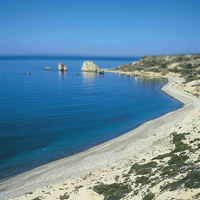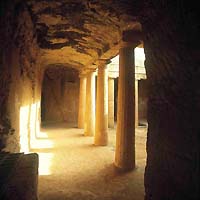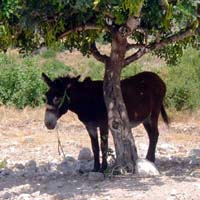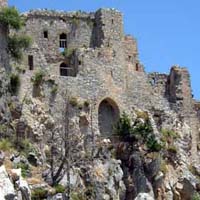Cyprus:
This isn’t some unsubstantiated myth, occurring somewhere on an island famed for its worship of Aphrodite, the Greek goddess of love. Rather, it’s a tale that takes place during the Crusades, featuring heroic prisoners, an epic battle and the miraculous recovery of the king’s seal. It all ends like a romantic fairytale—surely one that Aphrodite orchestrates—with the wedding of King Richard to the beautiful Berengaria. So, here I am, standing at a lookout tower in the very castle where King Richard’s royal wedding took place more than 800 years ago in the city of Lemesos on the island of Aphrodite, better known today as Cyprus. Palm trees, narrow winding roads, the minaret of a mosque and the dome of a Greek Orthodox church stretch before me. My Cypriot friend Oriana is acting as my unofficial tour guide and gives me yet another piece of mind-numbing information about all the people who have conquered her tiny island—Greeks, Romans, Byzantines, Lusignans, Ottomans, and the British, to name a few.
So, here I am, standing at a lookout tower in the very castle where King Richard’s royal wedding took place more than 800 years ago in the city of Lemesos on the island of Aphrodite, better known today as Cyprus. Palm trees, narrow winding roads, the minaret of a mosque and the dome of a Greek Orthodox church stretch before me. My Cypriot friend Oriana is acting as my unofficial tour guide and gives me yet another piece of mind-numbing information about all the people who have conquered her tiny island—Greeks, Romans, Byzantines, Lusignans, Ottomans, and the British, to name a few.
“Everyone has been here,” she says, laughing. “We’re always in the way. Everyone seems to land in Cyprus by accident, always after a storm, it seems.” Not me, I think. I’m not here by accident. I’m here for a mini-college reunion with my friends, Oriana and Adonis, whom I met in a Texas university, of all places. After graduation, Oriana spent years trying to entice me to visit by showing me fancy picture books of medieval castles, ancient Greek and Roman ruins and beautiful Mediterranean resorts.
What finally made me decide to visit Cyprus was the fact that I wanted to visit a Greek-speaking island and take a cruise to Egypt to see the Giza Pyramids. Cyprus is perfectly situated geographically at the crossroads of East and West. It’s off the beaten path for most North American travelers and is best visited as a side-trip from Europe. As the third largest island in the Mediterranean, Cyprus is an arm’s throw away from Greece, Egypt, Turkey and Israel.
Lemesos, the place where King Richard the LionHeart got married, is a great place to start any visit to Cyprus. I made it my home base as I explored some of Cyprus’ best-known tourist attractions—the ruins of ancient Kourion and the Sanctuary of Apollon Ylatis.
Arriving at ancient Kourion, it’s obvious the early settlers who chose to live here permanently around the 13th century B.C. had a great eye for real estate. Kourion’s amphitheater is perched high on a hill overlooking the Mediterranean and is a popular entertainment venue where concerts and plays are often held.
The Sanctuary of Apollon Ylatis, about a mile west of Kourion, heightened my sense of Cyprus’ history even more. This is a must on any itinerary. An earthquake destroyed the original complex in 365 A.D. The sanctuary was established in the 8th century in honor of Apollo, god of the woods. It includes the ruins of an arena, baths and dormitories, which are fun to clamber through.
A 30-minute drive from Lemesos is the laid-back coastal town of Pafos. With its 40,000 residents, Pafos is compact enough to get acquainted with fairly quickly. Small beach resorts, the proximity of the Akamas Peninsula wilderness and the nearby Troodos mountain villages with beautiful monasteries lured us to this place. Pafos’ whitewashed villas, bordered by bougainvilleas bursting with orange, red and pink flowers, also make the town a perfect summer getaway. Mountains frame the town on one side, the cobalt blue sea on the other. Just like a postcard. No wonder Cypriots made it their capital during Greek and Roman times.
Like the rest of Cyprus, Pafos is littered with wonderful archaeological treasures, including many World Cultural Heritage sites. The Tombs of the Kings is my favorite. It’s a necropolis, from around the 3rd century B.C., which sprawls out languorously among scenic seaside resorts. It contains underground tombs and chambers, and I felt like an archeologist, burning and sweating in the hot summer sun, while traipsing up and down stairs carved out of rock. Oddly enough, the Tombs of the Kings gets its name not because it was the burial place for kings, but rather from impressive Egyptian-inspired pillars, atriums and secret niches built by nobles who were laid to rest here.
Other Pafos archeological treasures are the 3rd century Roman villas discovered accidentally in 1962, which showcase the tessera, or tiles, that wealthy Roman residents used to decorate their homes. The House of Dionysos has the most interesting mosaics. In the afternoon sun, the mosaics seem faded, dusty, brown and red. But each mosaic still tells a story: Dionysos in a chariot with a wreath on his head. Blue flasks of wine. Leopards and centaurs leading the way in a parade. It’s all about good wine, good food, good friends—idyllic Mediterranean way of life.

After enjoying Cyprus’ coastal cities, we head to Lefkosia, Cyprus’ capital—ready for a little nightlife. Lefkosia is a fascinating 1,000-year-old walled city. The artsy area of Lefkosia is close to the Famagusta Gate, one of three original entrances to old Lefkosia. There are trendy clubs, restaurants and theaters.
As we make our night crawl through Lefkosia, Adonis points out the most interesting sight yet, the Green Line. The Green Line divides Lefkosia into north and south. It’s highlighted by old landmarks, bombed-out buildings enclosed in barbed wire and a U.N. peacekeeping force.
In 1974, Turkey invaded Cyprus, and the Green Line divides Cyprus into Greek-and Turkish-speaking regions. The only country to recognize northern occupied Cyprus is Turkey, which calls itself the Republic of Northern Cyprus. You can visit northern Cyprus from Lefkosia, but you can’t get your passport stamped if you wish to return to Greek Cyprus. The U.N. checkpoint issues a visitor’s day pass, and travelers need to keep this with them at all times.
So having traveled this far, I couldn’t leave without spending at least a day in northern occupied Cyprus. Oriana and I meet up with a Turkish-Cypriot friend of hers, Emir, outside the Ledra Palace, the headquarters for the U.N. peacekeeping force.
My favorite discovery is Kyrenia, a quaint town I consider to be the prettiest in Cyprus, about a 30-minute drive from northern Lefkosia. Kyrenia is Pafos’ slightly more beautiful twin, I think.
We head to Kyrenia’s old harbor, dominated by stone fortresses built around the time of the Crusades. We have frappes, a Greek coffee drink at an outdoor café, only to be interrupted by well-fed stray cats, slinking their way into the shade to escape from the heat. We walk the promenade, look out onto the marina filled with pretty fishing boats and yachts. Our only company are a few locals hanging around, swimming and fishing.
Our last stop is Saint Hilarion Castle, a must-see while in Kyrenia. The fairytale castle hovers on the edge of a mountain and served as a summer resort for the Lusignan conquerors of Cyprus. Originally, the castle was built as a watchtower to monitor the approach of Arab pirates who launched a series of raids in Cyprus beginning in the 7th century. The castle now inspires tales of adventure and romance. Emir says that even Walt Disney himself may have used this castle as his inspiration for one of Disney’s logos.
From the royal apartments, which we reach by climbing steep, worn steps, we look down on the overgrown garden and try to imagine how it looked all spruced up during the castle’s more majestic times. At this height, we can even see the Taurus Mountains in Turkey, some 60 miles away across the Mediterranean Sea. We eye Prince John’s tower, located at the convergence of three steep precipices. There’s so much to explore: stables, a church, courtyards, kitchen, basements, hallways, chambers, and ramparts.
As we make our way down the steps, my friends point to a castle a few miles down the mountain range and unlock another romantic tale about star-crossed lovers whose romance ended in tragedy. My friends point out Kantara Castle, where one of Kyrenia’s queens kept Arodafnousa, a beautiful peasant girl who the king loved. Arodafnousa became pregnant, just as the king left to fight in the Holy Land. The queen waited until the king was safely away, then locked Arodafnousa in the castle and starved her to death.
“The flowers seen everywhere here in Cyprus are named after her—Arodafnes,” Oriana explains.
My last day in Cyprus ends with a tale of romance, and with this fitting farewell, I say goodbye to Aphrodite’s island
